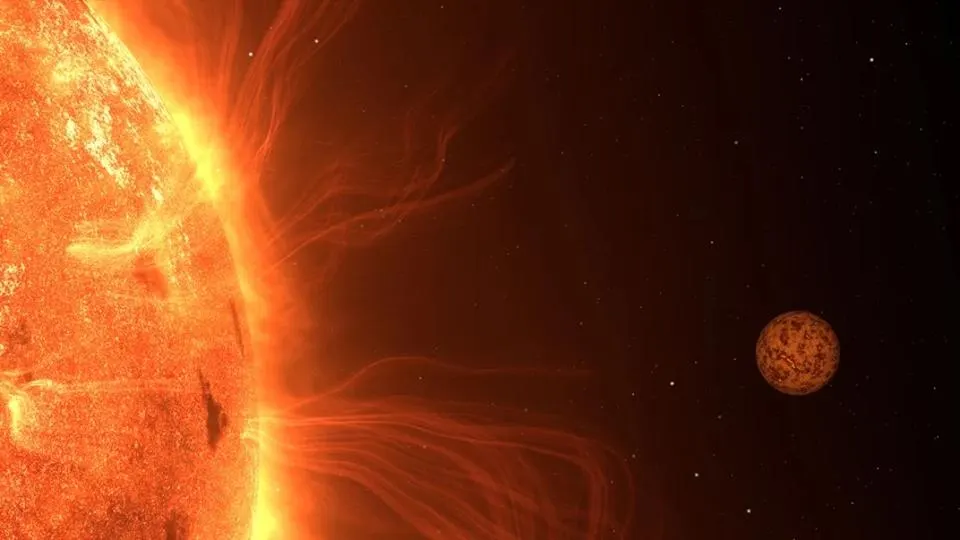Trappist-1 b: New Clues About an Earth-Like Planet's Atmosphere

A new discovery by the James Webb Space Telescope (JWST) could mean that an Earth-sized planet in the nearby Trappist-1 star system may have an atmosphere after all. The finding may change our understanding of exoplanets, following years of speculation about the nature of planets in the Trappist-1 system. This system, only 39 light-years from Earth, has captured the imagination of astronomers since its discovery in 1999, especially when NASA revealed in 2017 that it hosts seven rocky planets, three of which orbit in the habitable zone—the "Goldilocks zone"—where conditions might be just right for life.
Trappist-1 b, the innermost planet of this system, has long been the source of debate. Early studies had concluded it to be a barren, rocky world, devoid of any significant atmosphere. The scientists thought that because it is so close to the star, the evaporation of such an atmosphere would have resulted in an overall dark and barren land. However, new observations using JWST at mid-infrared wavelengths contradict these assumptions. Instead of confirming Trappist-1 b as an airless rock, two interesting possibilities open up: that the planet either has signs of geological activity with an airless surface or, much more excitingly, that it has a hazy carbon dioxide atmosphere.
And the first scenario is not off the table, after all: that Trappist-1 b might be a dark, airless rock. This would imply that the surface of the planet does not exhibit any considerable weathering, possibly due to volcanic or tectonic activities that can be considered as a result of geological processes. The presence of such processes in the formation of planets in our solar system may be able to provide crucial clues on the history and composition of Trappist-1 b. However, the second scenario, which suggests a thick, carbon dioxide-rich atmosphere, is gaining popularity based on new observations from JWST. The second scenario brings to mind comparisons with Titan, Saturn's largest moon, with a thick, nitrogen-rich atmosphere and methane-based weather systems.
This new study represents a huge leap in understanding Trappist-1 b, but it also highlights the inherent difficulties in studying exoplanets located light-years away. Observing the atmosphere of distant planets is an extremely challenging task. In some cases, the atmosphere of a planet like Trappist-1 b can be detected when it passes in front of its star, but only if it has a specific composition. The star at the center of the Trappist-1 system is a red dwarf—a smaller, cooler star that often shows flares and starspots. These may interfere with the delicate measurements that will be necessary to analyze the planet's atmosphere.
The researchers utilized the advanced infrared capabilities of JWST to observe Trappist-1 b behind its star and hence permitted the observation of the heated dayside of the planet. This technique is particularly useful because it gives a view of the planet's surface and atmosphere without interference from the light of the star and is known by the term secondary eclipse observations. These data showed that the surface temperature of Trappist-1 b is sufficient to support an atmosphere, whether one thick and full of carbon dioxide or, as people had thought before, there was no atmosphere at all.
For exoplanet researchers, this is quite a big deal. The potential atmosphere of Trappist-1 b may represent a completely new kind of planetary chemistry, quite unlike anything seen in our solar system. "The chemistry in the atmosphere of Trappist-1 b is expected to be very different from Titan or any of the solar system's rocky bodies," said Dr. Michiel Min from the SRON Netherlands Institute for Space Research. This promising prospect means the atmosphere hosted by this planet may harbor specific features and, thus, new ideas arise concerning the formation and the evolutionary history of rocky planets in other star systems but not our solar one.
The Trappist-1 b planet is only one of many elements examined in this planetary system. There are many planets that orbit a small cool red dwarf star like the Sun. These stars comprise about 70% of the stars that exist in our galaxy; hence, these are crucial stars for life beyond Earth. Since they are highly abundant, any planets around red dwarfs are seen as the prime targets to study temperate, rocky exoplanets. According to Elsa Ducrot, one of the co-lead authors of the study, "Planets orbiting red dwarfs are our best chance of studying for the first time the atmospheres of temperate rocky planets."
The findings by JWST can unlock a treasure trove of information about the Trappist-1 system and exoplanetary atmospheres at large. As astronomers refine their techniques and gather even more data, they will be able to further determine whether Trappist-1 b actually does have an atmosphere and what that atmosphere is composed of. In the process, they may find some evidence for conditions that would enable life to exist on other planets, deepening our appreciation for the vast and varied universe beyond our own.
For now, at least, the mysteries of Trappist-1 b continue to excite and inspire researchers. With each new discovery, we inch closer toward answering fundamental questions about whether life elsewhere in the cosmos is possible. As observations are made and data continue to be analyzed, there may come a day in which we realize that, far from being just another rocky planet, Trappist-1 b represents a world that could carry the building blocks of life.



